Top speed 513 km/h Range 1,853 km Weight 29,000 kg | Wingspan 40 m Length 32 m Cruise speed 485 km/h | |
 | ||
The Transall C-160 (often C.160 or simply Transall) is a military transport aircraft, designed and produced as a joint venture between France and Germany, Transall being an abbreviation of the specially formed consortium Transporter Allianz, comprising the companies of MBB, Aerospatiale and VFW-Fokker. It was initially developed to meet the requirements for a modern cargo aircraft for the French and German Air Forces; export sales were also made to South Africa and to Turkey, as well as a small number to civilian operators.
Contents
- Two transport aircraft transall c 160 common low pass in hamburg fuhlsbuettel
- Origins
- Production
- Overview
- Upgrades and improvements
- Operational history
- Variants
- First generation production
- Second generation production
- Military operators
- Civil operators
- Accidents and incidents
- Specifications C 160
- References
The C-160 proved to be a long-lasting design, remaining in service more than 50 years after the type's first flight in 1963. It has provided logistical support to a number of overseas operations and deployments; and has also served in specialist roles such as an aerial refueling tanker, electronic intelligence and communications platform. The C-160 will be replaced in French and German service by the Airbus A400M Atlas.
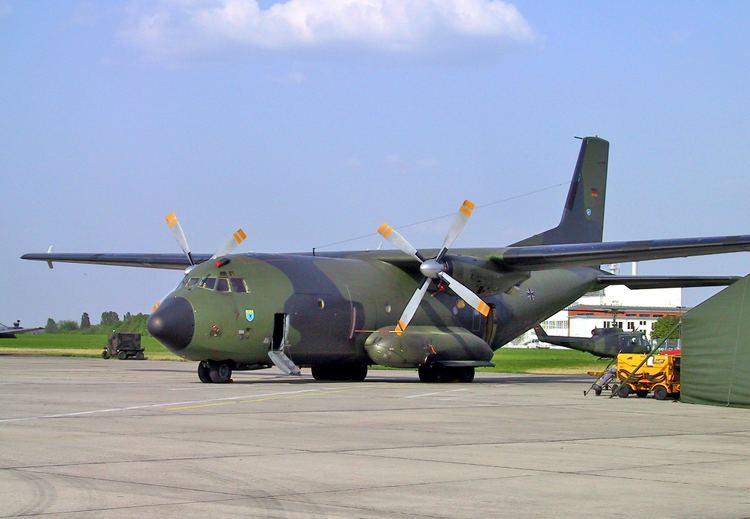
Two transport aircraft transall c 160 common low pass in hamburg fuhlsbuettel
Origins
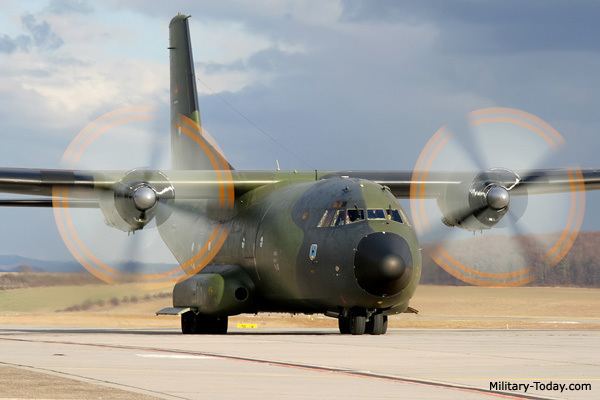
In the late 1950s, a requirement arose to replace the piston-engined Nord Noratlas transports operated by both the air forces of France (Armée de l'Air) and Germany (Luftwaffe). Keen to encourage industrial co-operation between the two countries, as had happened under a previous arrangement in which Noratlases for German service had been built under license by Weser Flugzeugbau, France and Germany signed an agreement for the development of a Noratlas successor on 28 November 1957. The Italian government also became involved in the project early on to meet their own requirements, however Italy's participation in the fledging program was soon terminated in favour of a smaller and entirely domestically-built aircraft, the Fiat G.222.
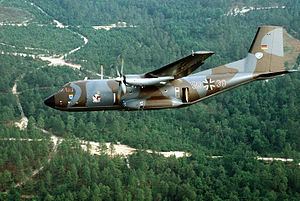
A consortium, "Transporter-Allianz" or Transall, was formed in January 1959 between the French company Nord Aviation and the German companies Weser Flugzeugbau (which became Vereinigte Flugtechnische Werke (VFW) in 1964) and Hamburger Flugzeugbau (HFB) to design and build the new transport. The new aircraft was required to carry a 16,000 kilograms (35,000 lb) cargo over a range of 1,720 kilometres (930 nmi; 1,070 mi) or a load of 8,000 kg (18,000 lb) over a range of 4,540 km (2,450 nmi; 2,820 mi) and be able to operate out of semi-prepared airstrips. One prototype was built by each of the production partners, with the first (built by Nord) flying on 25 May 1963, with the VFW and HFB-built prototypes following on 25 May 1963 and 19 February 1964. These were followed by six pre-production examples, stretched by 51 centimetres (20 in) compared with the prototypes, which flew between 1965 and 1966.
Production
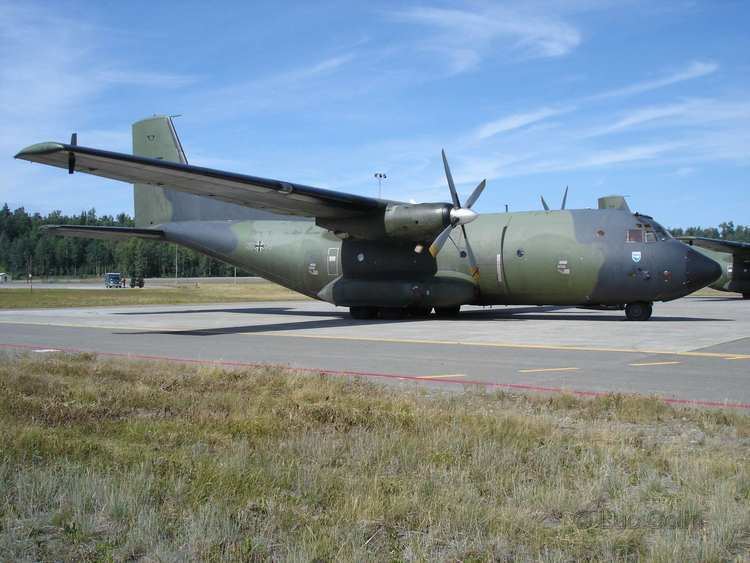
Production orders were delayed by attempts by Lockheed to sell its C-130 Hercules transport to Germany; these attempts were rebuffed, and a contract was signed for 160 C-160s (110 for Germany and 50 for France) on 24 September 1964. The manufacturing work-share was split between Germany and France in line with the number of orders placed; Nord built the wings and engine nacelles, VFW the centre fuselage and horizontal tail, and HFB the forward and rear fuselage. The aircraft's tailfin was to be built by Dornier. Three production lines were set up to assemble these components, one run by Nord, and the other two by VFW and HFB.
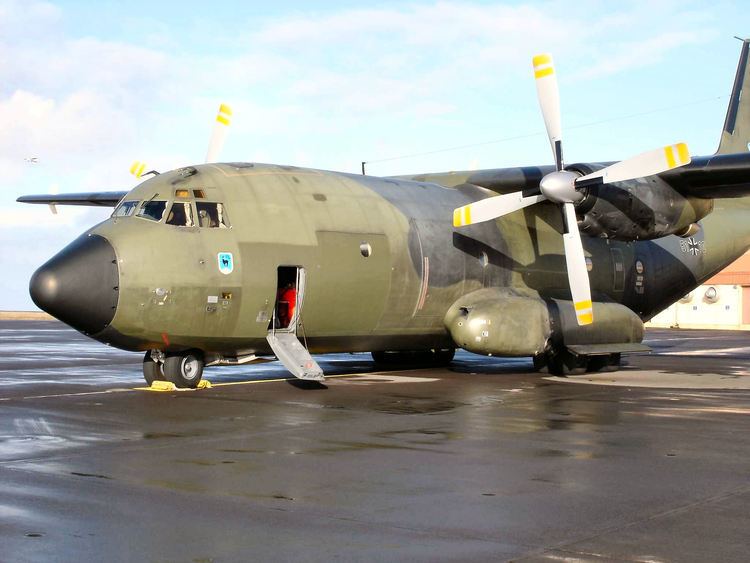
The first production airframes were delivered to France and Germany from 1967. The first batch included 110 C-160Ds for the German Air Force (Luftwaffe), 50 C-160Fs for the French Air Force, and nine C-160Zs for the South African Air Force. Four C-160Fs were converted to C-160P air mail transport aircraft, and were operated by Air France. Production continued until October 1972. Britain expressed interest in both procuring and manufacturing C-160s; while talks took place between Transall, the British Aircraft Corporation, and the British Government, the C-130 was opted for instead.
In July 1977, France placed an order for 25 aircraft to be built to an updated standard. The production workload for the new aircraft was split 50-50 between Aérospatiale (the successor to Nord) and MBB (which had absorbed VFW and HFB), with a single assembly line in Toulouse. The new version lost the cargo loading door on the port side of the fuselage, but gained provision for additional fuel tanks in the wing centre section. When fitted these tanks increased fuel capacity from 19,000 litres (4,190 imp gal) to 28,000 litres (6,170 imp gal). The aircraft were also fitted with updated avionics. The first second generation C-160 took flight in 1981. Aircraft produced in this batch included 29 for France (an additional four non-standard aircraft were constructed for special missions), and 6 for Indonesia.
Overview
The Transall C-160 is a twin-engine tactical transport; featuring a large-volume cargo hold, a rear-access ramp underneath an upswept tail, a high-mounted wing and turboprop engines. As designed, the C-160 can perform cargo and troop transport duties, aerial delivery of supplies and equipment, operate directly from frontline positions, and evacuate casualties. The fuselage cross-section had been designed to be compatible with international railway loading gauges to ease cargo logistics and the loading process; in flight the cargo area is pressurised and kept at a constant temperature by integrated air conditioning systems.
One aspect of the C-160 that made the type well suited to tactical operations was the type's short airfield performance; including the ability to perform steep descents of up to 20 degrees and perform landings on airstrips as short as 400 meters. In the airlift role, a later production C-160 could carry up to 8.5 tons across a distance of 5,000 kilometers, and take off from airstrips as short as 700 meters. Dependent upon aircraft configuration, a single aircraft could airdrop as many as 88 paratroopers or transport up to 93 equipped troops.
The C-160 is powered by a pair of two Rolls-Royce Tyne turboprop engines, which drives a pair of four-bladed Dowty Rotol propellers. The advantages of the twin-engine configuration include reduced unit and production cost, lower weight and fuel consumption, simplifying aircraft design and reliability. Each engine is equipped with an auxiliary generator system, providing the aircraft with both electricity and hydraulic pressure; an auxiliary power unit is used to power the aircraft while on the ground, and for rare use in mid-air emergencies.
Upgrades and improvements
An updated second generation of the C-160 was produced during the 1980s. Amongst changes made, the second generation was equipped with additional fuel tankage, aerial refuelling probes, and avionics improvements. While there were considerably changes to aspects of the cockpit, such as the navigational and autopilot systems, the second generation C-160 was intentionally designed with identical operating characteristics in order for crews to be interchangeable between older and newer aircraft without difficulty. The second generation C-160s were also designed for potential adaption to perform other roles such as maritime patrol and aerial fire fighting.
The C-160 proved to be a versatile aircraft, leading to a long operational service life. Between its introduction and 1999, approximately 2000 modifications and upgrades were incorporated upon the type, split 60/40 between the structure and equipment respectively. Many changes were made over time in regards to the aircraft's avionics: particular attention was paid in Luftwaffe refurbishments to the navigation and flight control systems, onboard data management computers and radar system, incorporating new features such as GPS and laser inertial navigation systems, modern autopilot and crew management systems, and a greater degree of cockpit integration.
Other improvements and additions to the type include protective kevlar armouring, electronic warfare management systems, chaff/flare dispensers, missile approach warning systems, TCAS collision warning system, new internal intercom and re-wiring. Extensive efforts have been made by both France and Germany to extend the aircraft's operating lifespan up to and if necessary beyond 55 years to 2018. For example, in 2003–2004, Germany signed separate contracts with Terma A/S and Northrop Grumman to upgrade the aircraft's electronic warfare self-protection and missile approach warning systems.
Operational history
In April 1976, the French Air Force used 12 C-160s in support of Operation Verveine, airlifting Moroccan troops and equipment to Zaïre during a border conflict with Angola. In May 1978, several C-160s dropped paratroopers of the French Foreign Legion during the Battle of Kolwezi.
In 1977, the French Air Force ordered an updated version designated C-160NG, for Nouvelle Génération ("New Generation"). From 1981, 29 of these aircraft were delivered, half of them configured as tanker aircraft for aerial refuelling. Another four were configured as C-160H Astarté TACAMO aircraft for communication with submerged submarines, a vital component of France's nuclear deterrent system.
In a final conversion, two aircraft were furnished for SIGINT electronic surveillance, designated C-160G Gabriel, replacing the Noratlases that had been in this role previously. In routine operations, the C-160Gs would often supplement France's Boeing E-3 Sentry AWACS aircraft. In 1991, a SIGNIT-equipped C-160G was deployed as part of France's contribution to Coalition forces during and after the Gulf War to support a no-fly zone and embargoing of Iraq.
C-160s were in continuous use to support French bases in sub-Saharan Africa; the tanker variants also proved valuable in supporting African operations. The C-160 fleet was the staple of the French military airlift capability for many years, supplemented by small numbers of McDonnell Douglas DC-8s, CASA/IPTN CN-235 and Lockheed C-130 Hercules as of 1990.
During the South African Border War during the late 1980s, the South African Air Force's C-160s were vital for deploying and supplying troops in the border region and into positions in southern Angola due to the otherwise-impassable terrain. The importance of air power in the war led to a great deal of the fighting being centered upon remote airstrips, both sides trying to gain or deny the same advantageous positions and place stress upon the opposing force's logistical efforts.
The C-160 has been a prominent component of several other international efforts. Germany's C-160 fleet has been used to support peacekeeping efforts in Sudan, a regular detachment of C-160s was also dispatched in support of the multinational International Security Assistance Force presence in the Afghanistan. Both French and German C-160s were used in supporting Operation Serval, the French-led intervention in the Northern Mali conflict. For either humanitarian or military purposes, C-160s have conducted extensive operations in a number of nations, including Mauritania, Niger, Chad, Ethiopia, Bosnia, and Lebanon.
Starting in 1984 onwards, German airframes underwent LEDA I and LEDA II life extension measures, which were focused on the wings. Subsequent programs carried out in the 1990s, such as LEDA III, concentrated on the whole structure of the aircraft; raising the airframe life from 8,000 flights to 12,000 flights, and introducing new avionics systems such as a self-defence system and a replacement flight management system.
From 1994 to 1999, all French C-160s underwent an avionics upgrade and the addition of new anti-missile countermeasures. The C-160Fs and NGs so updated were redesignated C-160R (Renové—"renovated"). In 2009, the French Defence Ministry announced a modernisation of the C-160 fleet, enabling it to continue in service until 2018 if required.
In late 2011, it was announced that Germany's Transall fleet had accumulated a combined total of one million flight hours. As of 2012, the global C-160 fleet was approaching the end of its service life; all South African C-160s have already been retired, while the Turkish Air Force continued to operate 20 aircraft obtained from Germany (C-160T). To replace the Transall, the German, French and South African Air Forces ordered 60, 50 and eight Airbus A400Ms, respectively; the South African order was later cancelled.
In 2015, it was announced that the retirement of Germany's Transall fleet had been pushed back from 2018 to 2021 due to delays with the Airbus A400M; until 2021, a decreasing number of aircraft shall remain in service to perform missions that require the Transall's self-protection suite.
Variants
First-generation production
The initial production run of 169 aircraft were built by the three companies in France and Germany; Nord built 56 aircraft, VFW built 57 aircraft and HFB/MBB 56 (HFB became part of Messerchmitt-Bolkow-Blohm in 1969 during the production run). All three production lines produced a mixture of aircraft for France and Germany but the South African aircraft were all built by Nord.
Second-generation production
From 1981 on, some new C-160 reached the wings of Armee de l'Air. The now C-160NG (Nouvelle Generation, New Generation) called aircraft has a fifth fuel tank in the middle of the wing above the fuselage, a refueling probe while the left side cargo door was removed. Some first-production series C-160F were fitted with the NG-versions changes and renamed C-160R (Renové).
Beside these changes, French Air Force introduced the C-160G Gabriel, a version for electronic reconnaissance, easily to distinguish because of the antennas fitted to the aircraft.
Until the early 2000s, also the C-160H Astarte was used, while Astarté (Avion Station Relais de Transmissions Exceptionelles), meaning "airborne relay station for special transmissions", was used for communication with submerged French nuclear submarines.
Military operators
Since 1999, all the F and NG aircraft operated in French air forces have been converted to the last upgraded C-160R standard.
Civil operators
Accidents and incidents
Specifications (C-160)
Data from Jane's All The World's Aircraft 1982-83
General characteristics
Performance
